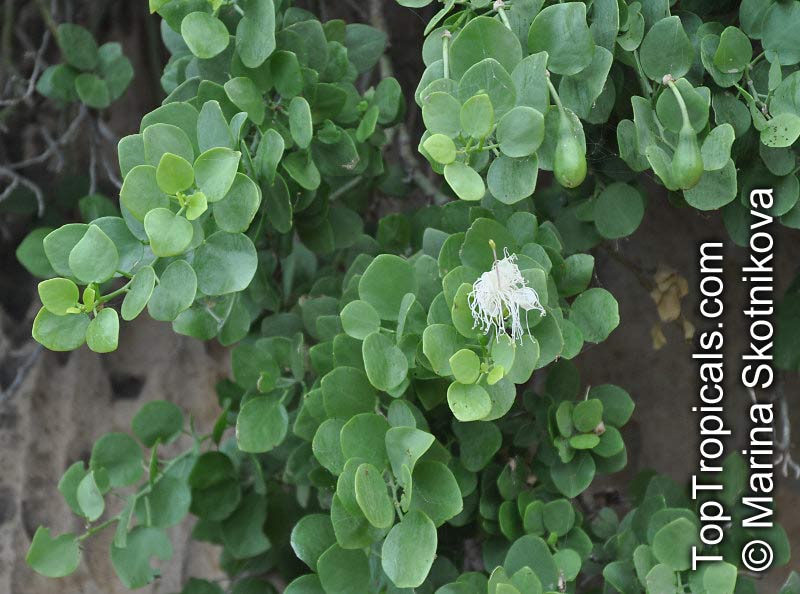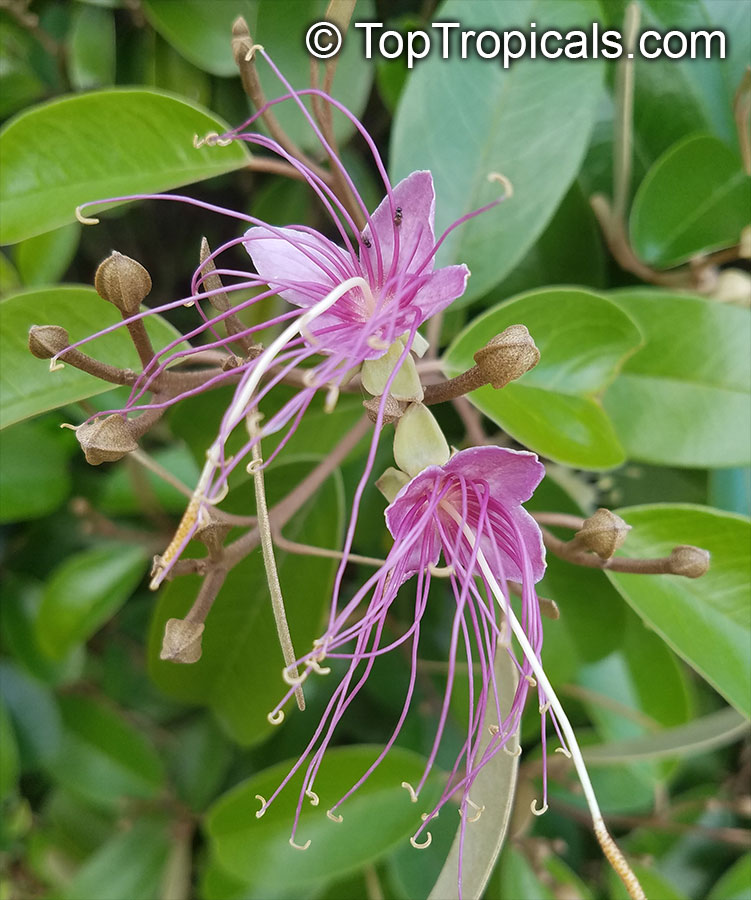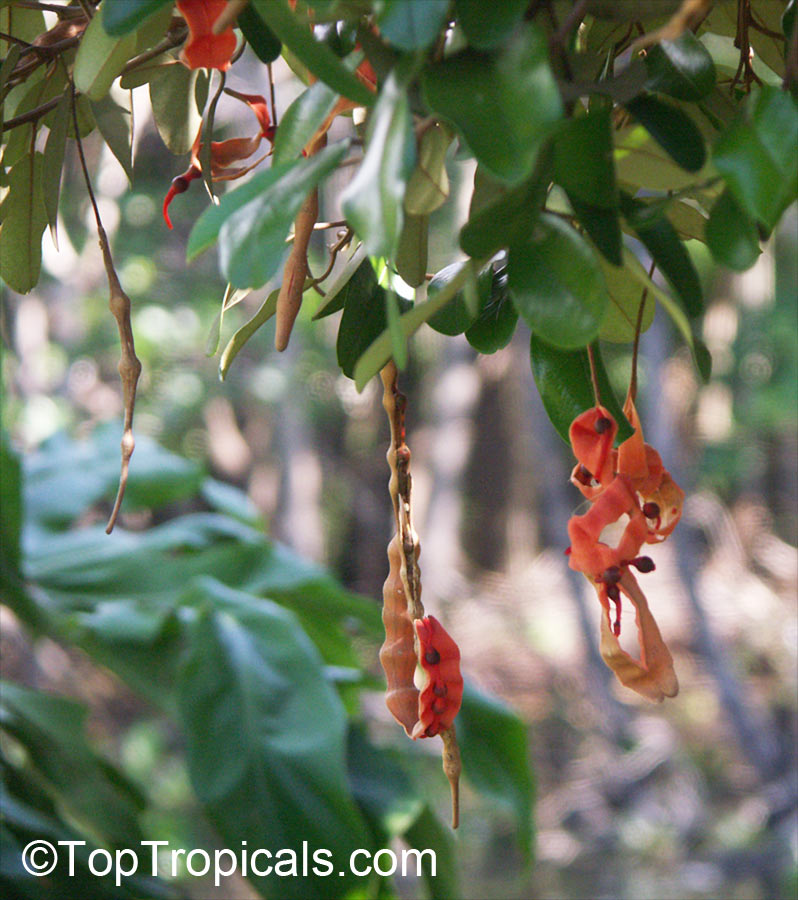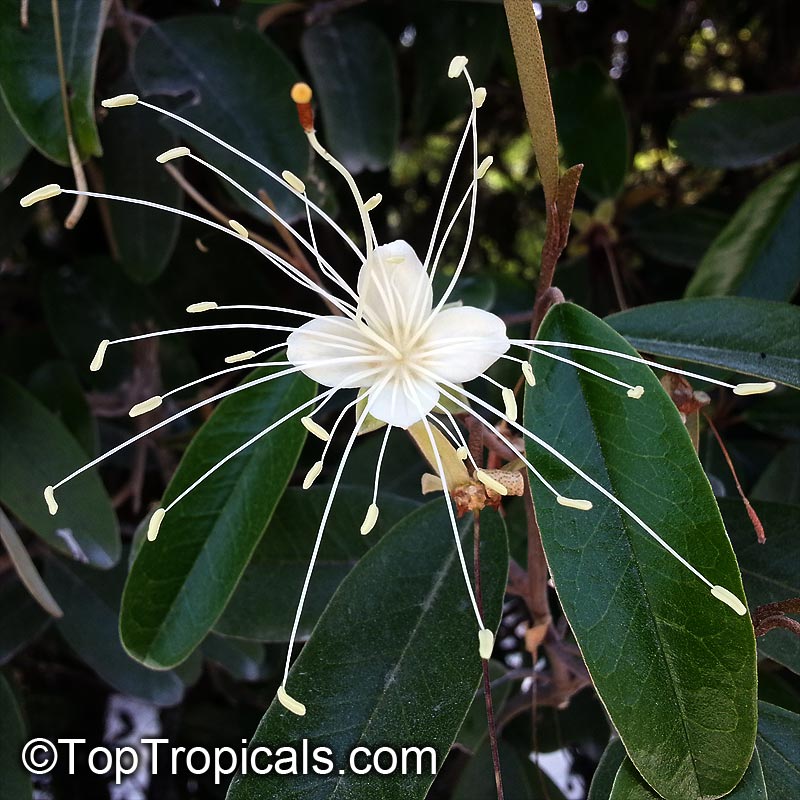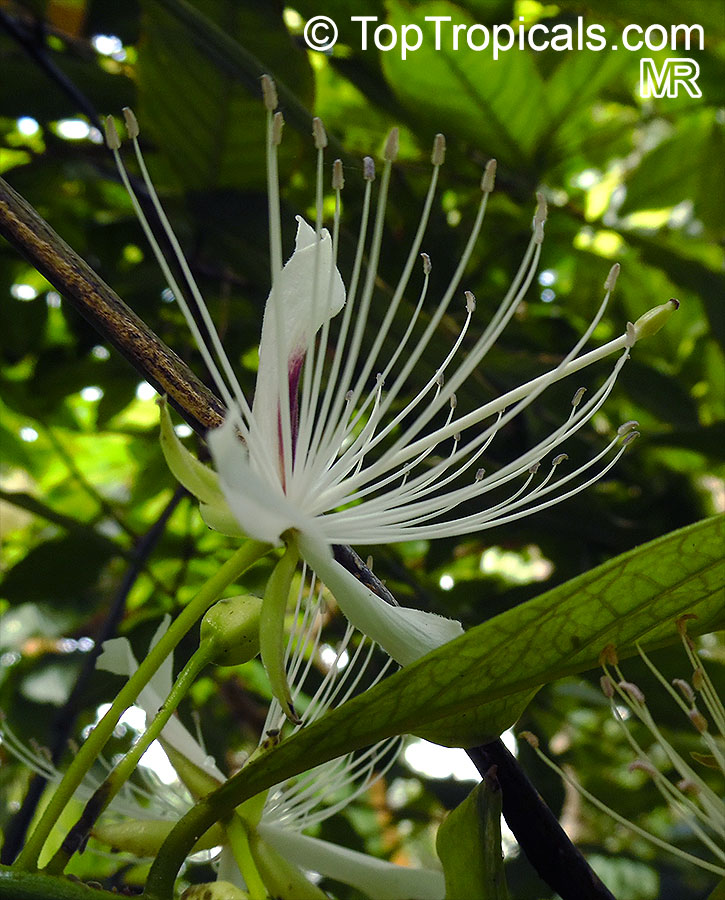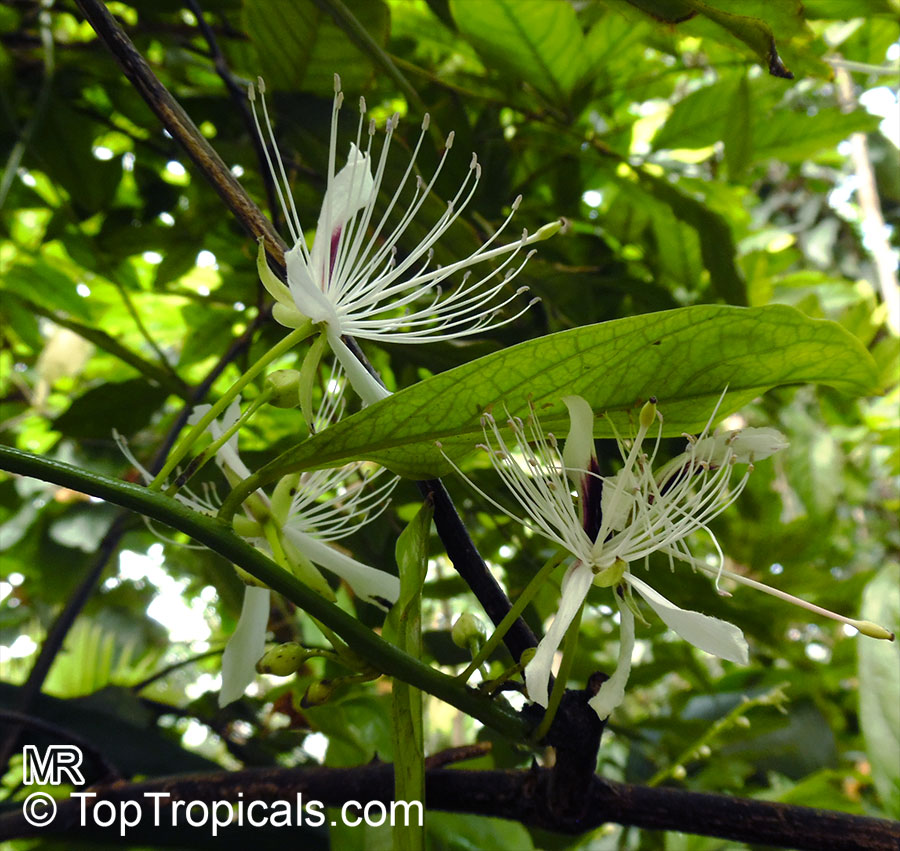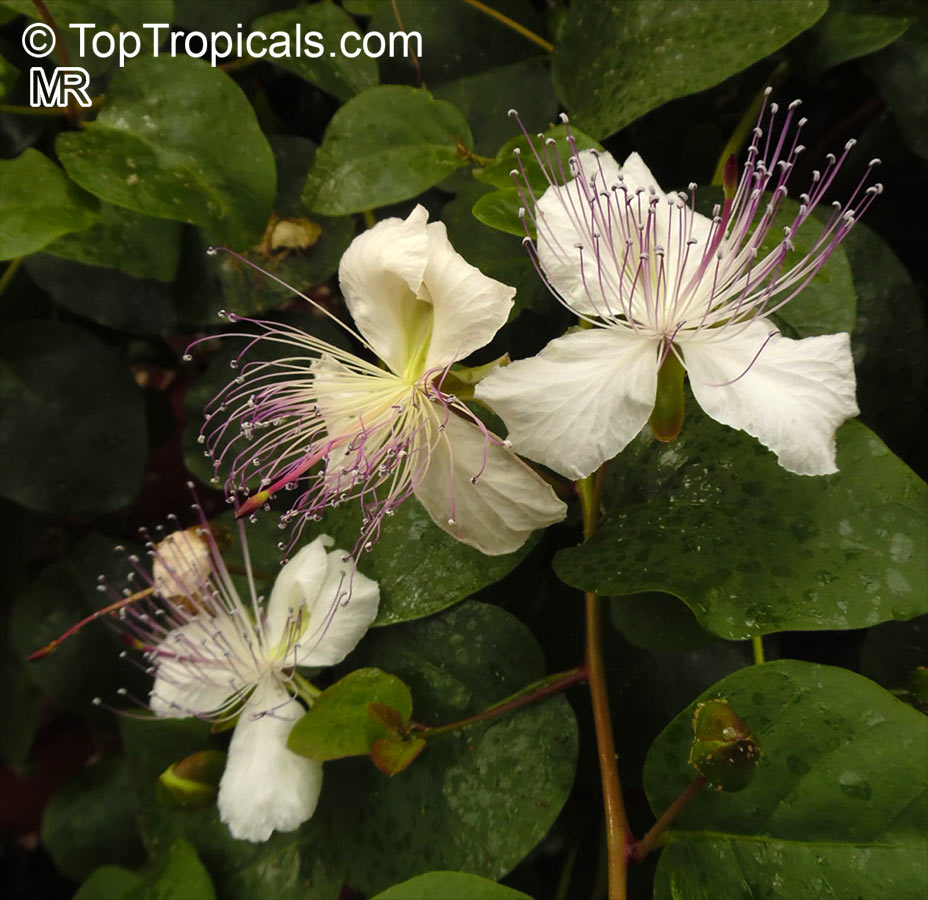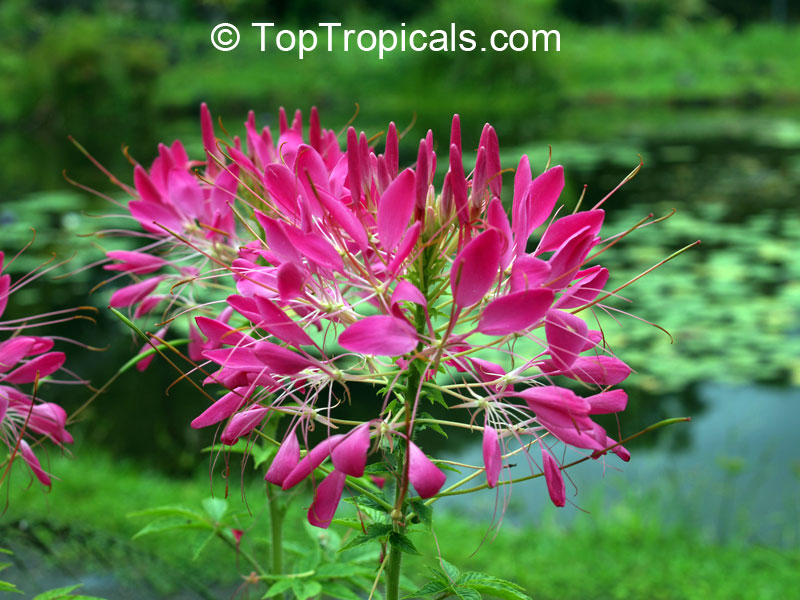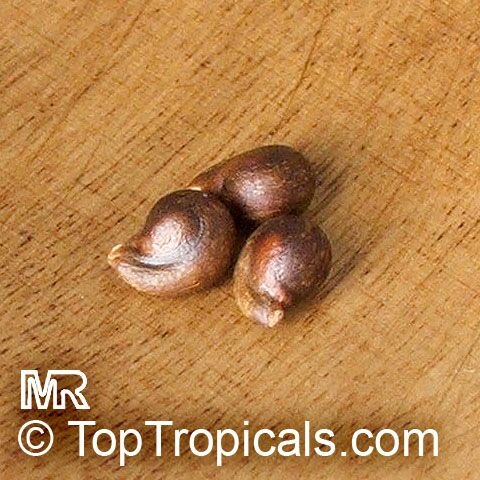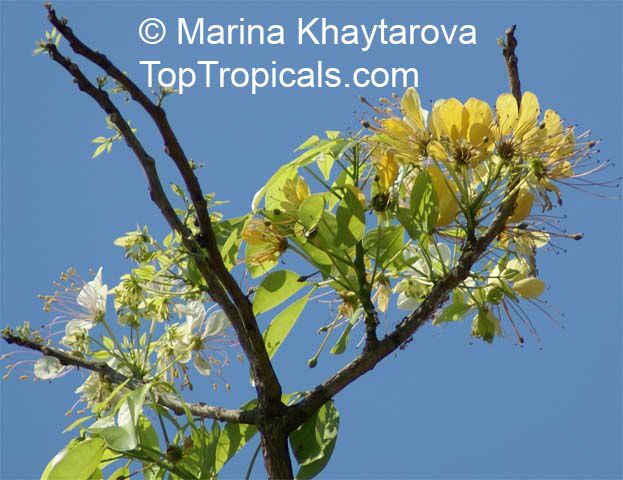Capparaceae - Botanical Family
| Number of plants found: 16 | Next | 
|
Go to page: | 1 | 2 |
Botanical names: Capparis cartilaginea, Capparis sinaica
Common name: Capparis
Family: Capparaceae
Origin: East Africa







Capparis cartilaginea is a small, scrubby tree which grows by spreading or 'scrambling' over rocks. It has long, hairless stems which are typically bent and twisted, with white-grey or yellowish-green bark, coated in a waxy or powdery bloom.
Botanical names: Capparis cynophallophora, Quadrella jamaicensis
Common names: Jamaica Caper Tree, Mustard Tree
Family: Capparaceae











It performs best in well-drained, semi-arid soil. Jamaica caper is drought tolerant, so regular watering is not necessary. This species is often noted for its water-wise traits.
Jamaica caper is a large shrub that grows 5-10 ft tall and can be used as a privacy screen, windbreak, and for erosion control. It has white to off-white flowers which are fragrant and attract butterflies and hummingbirds. Jamaica Caper is an ethnomedical plant that is known around the world and is used in traditional medicine in various cultures. This plant is drought tolerant and tough, and it is even cold hardy at least to 30s F for a short time. It is also ideal for seaside or salt-tolerant locations.
To grow a Jamaica Caper in a pot in cold regions, start by choosing a pot that is large enough to accommodate the size of the plant without overcrowding it. Plant in well-drained soil and place in full sun or semi-shade. Water moderately and make sure to check the soil before adding more water. To ensure the success of your plant, monitor for pests and diseases. Finally, for extra protection, cover the plant in mulch and bring it indoors during cold weather.
Botanical name: Capparis decidua
Common names: Karira, Retama Caper
Family: Capparaceae
Origin: Africa, Middle East, Southern Asia











Native to the regions of Africa, Middle East, and Southern Asia, Capparis decidua is a large shrub or small tree ranging in height from 5-20 feet tall depending on how much it is pruned. It has a moderate water requirement and is able to flourish in dry conditions. It is deciduous, with delicate pink flowers appearing throughout much of the year. As an ethnomedical plant, this species is capable of bringing a valuable range of medicinal resources.
Known as "Karira" in its native habitats, this species is often used as a spice or herb, adding a delicious flavor to traditional dishes. It is a perfect addition to any garden setting and is sure to attract butterflies and hummingbirds. Grown in USDA Zone 9-11, Capparis decidua is well suited to many climates.
The ideal environment for Capparis decidua is one that receives plenty of full sun and can be grown in large pots in cold regions. The soil should be well-drained but hold some moisture, though it can also be grown in sandy soils if watered judiciously. It is important to prune young plants regularly to help them to develop a strong shape, and mulch at the base of the plant to help retain moisture. Additionally, during the growing season it is beneficial to fertilize the plants every few weeks to aid healthy growth.
Botanical name: Capparis erythrocarpus
Common names: Pitipiti, Apana, Patahofuo
Family: Capparaceae
Origin: Africa








Capparis erythrocarpus, commonly known as Pitipiti, is a large shrub native to Africa that grows 5-10 ft tall. It is an ethnomedical plant, used to prepare decoctions for arthritis and other ailments, as well as being known as an aphrodisiac. Capparis erythrocarpus produces spectacular white or off-white flowers that attract butterflies and hummingbirds.
The plant is easily grown in USDA Zone 9-11 in areas that have full sun to semi-shade and moderate water requirements. Pitipiti can also be grown in pots, making it ideal for gardening in cold regions. When grown in containers, planted in a well-draining soil and given enough light and protection from prolonged cold, the plant will flourish and produce blooms. Watering should be done when the soil feels dry to the touch and fertilizing should be done after blooming and in springtime with an organic fertilizer. Pruning should take place in early spring to promote healthy growth and increase blooming.
Overall, Capparis erythrocarpus is an easy to grow shrub that requires minimal maintenance, yet provides beautiful flowers, heavily scented foliage and a rich history of ethnomedical use.
Botanical name: Capparis micracantha
Common names: Capertree, Chingchee
Family: Capparaceae
Origin: Eastern Asia







Capparis micracantha, also known as Capertree or Caper, is a small tree native to Eastern Asia. It typically grows 10-20 ft in height with an upright habit and a spreading canopy. Its branches bear evergreen leaves and white or off-white flowers, which emit a pleasant, fragrant scent. This plant is also an ethnomedical plant, used in traditional healing and steam baths to treat a variety of ailments.
In terms of growing conditions, Capparis micracantha requires full sun and moderate water. The plant is best-suited for USDA Zones 9-11, but can do well in other regions if given the right conditions. One way to grow this plant in cold regions is by potting it. This way, the plant can be brought in or outside as needed, and its root ball can be kept moist in winter months.
When caring for a potted Capparis micracantha, it is important to select a pot with a good drainage hole - one or two depending on the size of the pot - to help prevent root rot. Be sure to use a well-aerated soil mixture, ideally one made for cacti and succulents, and make sure to water the plant regularly, but don't over-water. Additionally, if the plant is placed outdoors, it should be protected from frost so as to not damage the roots. Overall, regular potting, fertilizing, and trimming can help the plant thrive.
Botanical name: Capparis spinosa
Common name: Caper
Family: Capparaceae
Origin: Egypt, Middle East and Asia











When grown in suitable climates, Capparis spinosa requires full sun and moderate water. Established plants are very drought tolerant and can survive extended dry or hot periods due to their deep, extensive root systems. In cold regions, Capparis spinosa is best grown in large pots which can be moved indoors or onto a sheltered porch during cold snaps. The plant's optimum soil type should be well-draining and (preferably) consisting of a base of coarser materials such as clay, gravel or sand. To maintain a reasonable hedge or groundcover, plants should be clipped every two to three months.
Capparis spinosa has small, pink or white flowers which attract both butterflies and hummingbirds. While not the most showy plant, it works well as a low-growing spiny hedge or groundcover, growing only 12 to 24 inches tall. It is also edible and offers ethnomedical qualities, as well as anti-inflammatory, antimicrobial and antioxidant properties. While an excellent alternative to more traditional hedge plants, Capparis spinosa can produce between one and nine fruits each year. While not very large (about the size of an olive), the fruits are full of flavor and have unique polyphenols that can make them an alternative to traditional spices. Capparis spinosa fruits offer a wide range of health benefits including antibacterial activity, relief from chronic diseases like diabetes and heart issues, and anticancer properties. Additionally, consuming some of the fruits have been linked to improved metabolism, better digestion and increased immunity.
Capers of commerce are immature flower buds which have been pickled in vinegar or preserved in granular salt. Semi-mature fruits (caperberries) and young shoots with small leaves may also be pickled for use as a condiment. Smaller buds (both with less than one centimeter diameter) are considered more valuable than the larger (more than 1" diameter). Capers have a sharp piquant flavor and add pungency, a peculiar aroma and saltiness to comestibles such as pasta sauces, pizza, fish, meats and salads.
Botanical name: Capparis tomentosa
Common name: Woolly Caper-bush
Family: Capparaceae
Origin: Africa










Mostly a robust woody climber but occasionally a shrub or small tree, armed with sharp, paired, hooked thorns. Flowers quite showy, yellowish-green with a mass of long white or pinkish stamens.
Botanical names: Cleome hassleriana, Cleome spinosa
Common names: Spider Flower, Crown Flower
Family: Capparaceae
Origin: Subtropical South America










A native of Subtropical South America, Cleome hassleriana (Spider Flower) is a small shrub that can grow up to 2-5 feet. For best results, this annual should be planted in full sun or semi-shade and should receive regular to moderate amounts of water. Expect to be rewarded with spectacular displays of pink, white, off-white, blue, lavender-purple colored flowers throughout summer, from July through September. Along with adding a beautiful look to the garden, the Spider Flower also attracts butterflies and hummingbirds.
For cold regions, Spider Flower can also be grown in a pot and planted outdoors when these regions experience warmer weather. To do this, the pot should be brought indoors during the colder months, in a warm and bright spot, and watered only when the top soil is starting to dry out. Alternatively, the pot can also be taken outside when the temperatures start to drop and should be brought back indoors when temperatures reach freezing.
For those who are looking to add a pop of color to their garden and attract wildlife Cleome hassleriana (Spider Flower) is a must-have! As it requires very little care and blooms throughout the summer months, this plant is the perfect addition to any green-space and will surely bring delight to the garden.
Botanical names: Cleome isomeris, Isomeris arborea
Common names: Bladderpod Spiderflower, Burro Fat
Family: Capparaceae
Origin: Arizona, California, Mexico








Needs good drainage and full sun. Can survive extended drought. Fast. Yellow flowers February to May. Strongly scented evergreen leaves. Very low water use, needs good drainage.
Botanical name: Crateva adansonii
Common names: Garlic Pear Tree, Three-leaf Caper, Obtuse Leaf Crateva
Family: Capparaceae
Origin: Southeast Asia











Flowers white or creamy in many flowered terminal corymbs.
| Next |  |
Use link to repeat this search:
https://toptropicals.com/cgi-bin/garden_catalog/cat.cgi?search_op=and&keyword_op=and&language=e&family=Capparaceae&number=10
&no_change_lang=1&user=tt&sale=1&first=0
